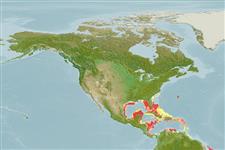Common names from other countries
Classification / Names / Names
Namen | Synonyme | Catalog of Fishes (gen., sp.) | ITIS | CoL | WoRMS
Environment: milieu / climate zone / depth range / distribution range
Ökologie
Pelagisch; brackwasser; tiefenbereich 0 - 274 m (Ref. 116013). Tropical
Western Central Atlantic: Belize and Bermuda. Tropical and subtropical.
Length at first maturity / Size / Gewicht / Alter
Maturity: Lm ? range ? - ? cm
Epibiotic but also found in the oceanic surface (epipelagic), neustonic (Ref. 116013). Known from mangroves (Ref. 86642, 86643) sheltered areas of bays and surface or near surface water layers, including porpitids and the halopelagic Sargassum fauna (Ref. 86643).
Life cycle and mating behavior
Geschlechtsreife | Fortpflanzung | Ablaichen | Eier | Fecundity | Larven
Members of the order Anthoathecata are mostly colonial A-form hydroids. Life cycle: The zygote develops into planula inside the gonophore and is later released as an actinula which metamorphoses into polyp stage.
Bouillon, J. and F. Boreo. 2000. (Ref. 3134)
IUCN Rote Liste Status (Ref. 130435)
CITES Status (Ref. 108899)
Not Evaluated
Not Evaluated
Bedrohung für Menschen
Harmless
Nutzung durch Menschen
| FishSource |
Tools
Mehr Information
Alter/Größe
Wachstum
Länge-Gewicht
Länge-Länge
Morphologie
Larven
Dichte
Internet Quellen
Estimates based on models
